Last Updated on by Mitch Rezman
“I’ve got a lot of addictions but not a lot of time so I’ve been going to polkaholics anonymous because they offer a two-step program” mitchr
So Popcorn our cockatiel, (pictured above) has become a prolific mom and if we put our hand within 12 inches of her in her cage, my arm will be ripped off by the doting mother sitting on 2 nonfertile eggs. We feel your pain and we are about to embark on a journey trying to figure out why this is happening and how to fix it.
Recommendations are to leave the egg(s) in place for 11 days past the time the last egg of the clutch is laid. Normal cockatiel clutches have about six eggs. Popcorn is sitting on two – does that impact her?
Caged bird keepers have to keep this in perspective because we are addressing two problems. The egg-laying problem and the health of the bird problem. Egg-laying depletes all sorts of calories and energies from any female bird so we want to make sure that the bird is getting plenty of calcium and protein to avoid pathologic fractures and accelerated aging.
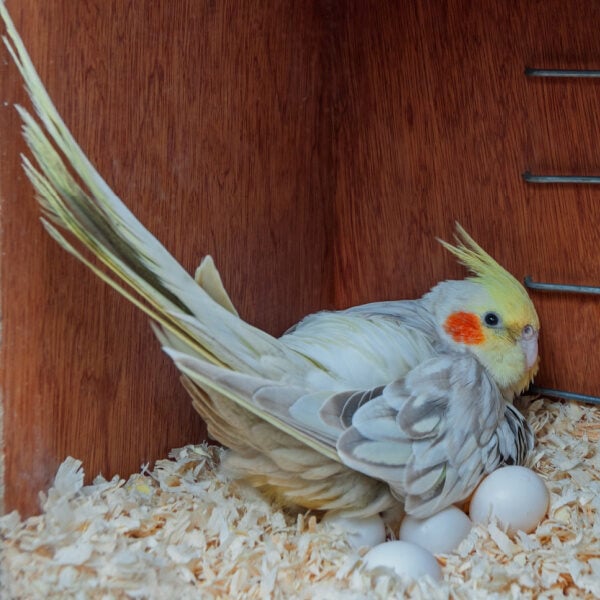
Good to know especially because apparently, cockatiels can lay unfertilized eggs 12 months a year, unlike many other species. I mean if you have two female cockatoos and one starts laying eggs she may cross stimulate the second cockatiel to begin the breeding cycle.
This is why we recommend that if your cockatiel is laying a lot of legs you need to take her to the vet just for a checkup to avoid larger medical complications down the line.
Our cockatiel Popcorn loves to hide behind towels in the bathroom, she likes the dark areas because she doesn’t have a nest box. So inevitably she chose the cage floor corner closest to a wall. I’m told that breeding female cockatiels will start to sit on a clutch once it reaches somewhere around six eggs. Popcorn, she is happy sitting on her two eggs, so there is no “normal” at will.
In the wild, egg-laying is normally stimulated by the length of the day which is considerably different in the areas that we find what cockatiels come from. Which is Australia, and macaws as well as many Conures coming from South America, consider North American light cycles a possible trigger.
There are so many environmental issues that we can assign chronic egg-laying triggers too. Anything from an all-seed diet, to illnesses we are not detecting (do you weigh your bird weekly?).
Was your bird very young when you acquired it? Is she imprinted on you and does the bird possibly see you as being her mother or one of her own species and a possible mate?
Excessive egg laying is bad, it can lead to egg binding which we spoke about last week. It can trigger feather and weight loss, an irritated or prolapsed cloaca, malnutrition, and weakness of the bones, something called osteoporosis yes even birds can get it.
What suggestions do we find for excessive egg-laying treatment? Start by looking at your bird’s cage in the environment and develop a plan. You don’t want to make changes quickly to add further stress to your hormonal parrots’ life.
If there’s more than one human in the household and the bird is bonded with one of two or more humans it’s time to work to get the bird to bond with others in the household interacting less with the primary bondee who may be perceived as a mate.
Wheel the birdcage to somewhere else in the home and then slowly begin to rearrange the interior of the cage.
If the bird has cage mates try to move them so that they are out of sight and if possible out of sound from the egg-laying bird (yes, that is a hard one to do).
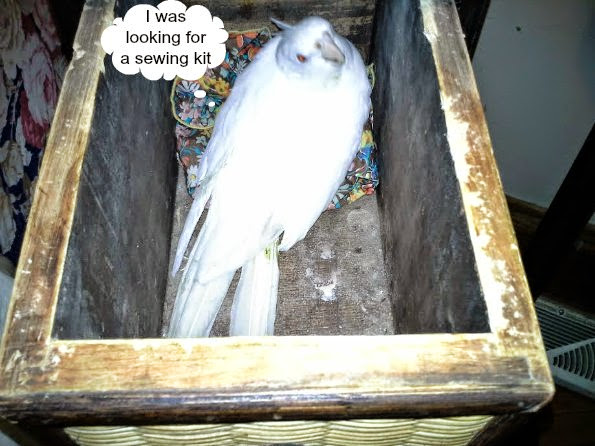
If you have mirrors in the cage, take them out as they may represent mates. The same thing holds true for small plastic things that resemble birds. Bells are great fun, but if your bird is especially attached to a bell and is regurgitating on it, then it has to come out. Create foraging opportunities to keep the bird’s mind occupied.
Offer no nesting or shredding material that can be used to build a nest. In as much as your bird may like warm soft foods or human food other than vegetables, these categories of food should be restricted from your bird’s diet at this time.
If possible this would be a good time to introduce pellets in your bird’s diet. A steady nutrient base would help over the main seed diet as the nutrition is incomplete and high in fats.
Here’s the light thing and we will get to that later, but there are some advocates of reducing the light cycle over birds cage down to eight or 10 hours to help reduce chronic egg laying.
I recommend a good avian veterinarian blood workup to see if your bird has any vitamin or mineral deficiencies.
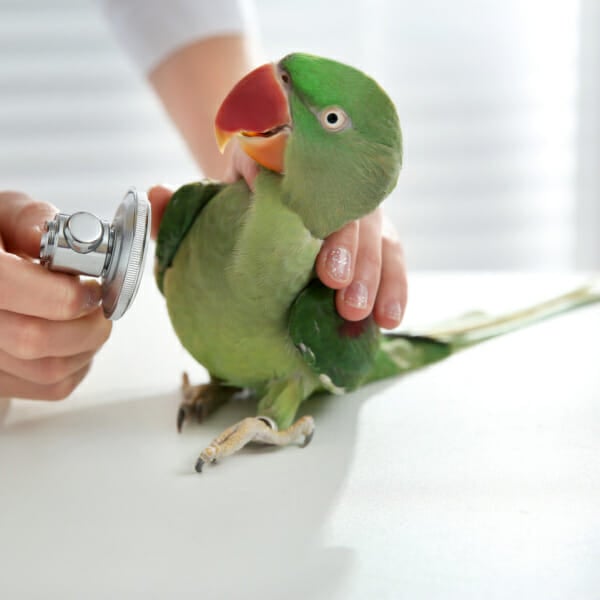
Veterinarian examining Alexandrine parakeet in clinic, closeup
If the bird is seriously compromised there are more extreme methods like the introduction of leuprolide or even surgery to remove the reproductive organs basically that would be “spaying” your bird.
I’m no expert but I think the surgery would be extreme and really dangerous given the small size of the bird’s reproductive system – I would label that high risk.
What should you do with the eggs? At this juncture, my vote is to let your bird sit on the eggs with the hopes that you could turn the “I need to lay more eggs” switch off. They should be left in the cage for 21 days if she lays just a few eggs and sits on them.
But, if she keeps laying eggs and if anybody’s eggs may be fertilized and you just don’t need any more birds. You can replace the eggs with fake eggs. admittedly we do not stock them so we are referring you to dummyeggs.com where they have a full range of sizes to accommodate most species.
We’ve actually just ordered a set for Popcorn and will report back at the appropriate time. If you have any feedback about this product we would love to hear it.
Remember parrots & parakeets don’t build nests with the exception of the monk parakeet. Parrots prefer cavities in things like trees and rocks, dark enclosed spaces. Popcorn loves the area behind the towels in the bathroom.
If there’s a nest box in the cage remove it. If you have a sleepy sack or tent in the cage, remove it. Do not offer shredding material and paper toys as they can be used to help build nests.
Don’t forget to look beyond the cage. Birds are brilliant engineers and a motivated female can repurpose almost any dark space from under your living room sofa to the dryer in the mudroom.
We are full advocates of always knowing where your bird is in the home to prevent accidents. It is especially true if the bird is a prolific egg layer.
One practice advocated on the Internet suggests that bird food be offered only 12 hours instead of around the clock. Meaning, if a bird has an unlimited supply of food they may think that there is plenty of food to feed a family. Whereas a reduction of the diet may cause the bird to feel there is not enough food to provide for the family thus reducing its confidence in raising more chicks.
We can’t say it enough. Weigh your bird regularly to help diagnose health issues. When a bird is in egg-laying mode is time to step up your game and weigh your bird at least twice a week if it will let you get near it without biting off your arm. We wait until Popcorn comes out of her cage for about 10 minutes once a night to handle her and maintain her cage.
Some veterinarians recommend flipping day and night to interrupt the breeding cycle. Make the room dark during the day and then introduce artificial light for eight or nine hours but during “our” night time.
Avian veterinarians may advocate inducing a molt because a molting hen will not lay eggs. You wait about a week after the hen lays her most recent clutch this may hormonally disrupt the next ovulation cycle and curtail egg-laying for the season.
You can achieve this by making physical environmental changes to the cage and the location of the cage itself which we had talked about earlier. Your avian veterinarian can introduce molt triggering drugs.
If your bird is not committed to sitting on the eggs in her cage. Use valuable out-of-the-cage time for clicker training and social interaction to take your bird’s mind off of breeding.
Interact with your bird physically, just NOT below the neck. Don’t stroke her back or her tummy as this may stimulate sexual/breeding behavior.
Many people get frustrated because the pet bird is ignoring them while it is hormonal so the pet is suddenly no longer appealing. It’s then easy to allow the bird to just not get out of the cage and thus not get exercise which is even more critical for the bird to get, because of its static state from sitting on the eggs for so many hours a day.
Not too long ago we wrote about the mysterious cuttlebone. Cuttlebone is one of the oldest and most common calcium supplements for breeding birds.
What I would like to talk about is a part of the feeding directions that many people miss. I quote from Harrison’s website “For chronic egg-laying birds, a consistent, continuous light for a total of 72 hours (3 days continuously). After 72 hours, resume normal daylight cycles.
Holy smokes! here are some FAQs from Harrison’s site:
I am concerned with how the continuous light will affect my bird. Will it be able to sleep? Won’t it stress my bird?
Your bird will be able to sleep in the light. Continuous light is much less stressful than chronic egg-laying or egg binding.
Can the lights be dimmed during the night or does the light need to be bright the entire 72 hours?
The same light without variation (brightness) must be used for the entire duration (3 days = 72 hours) for this to be effective.
What they don’t mention on the site that I learned through a thread between a customer and Harrison’s customer service is, the light that they are advocating should be 1000 lumens.
“Oh no Martha, I think we’re headed for a science lesson”
Will somebody with scientific authority answer the question “If my bird is sitting on the bottom of the cage 4 feet away from the thousand lumen lamp, my bird is only receiving 40 lumens of light? Are your (Harrison’s) directions predicated upon 1000 lumens or will 40 lumens be adequate?
This geek acquired a digital inverse square law calculator for his digital pocket protector.
alt=”inverse square law of light calculator”
To further muddy the waters, it’s our understanding that exposing a bird to 72 hours of light will shut down the reproductive system – period.
This is where I’ll man up and say I’m not really sure what the right path is to cure chronic egg laying in small birds. We’d sure like to get your input – below.
written by mitch rezman
approved by catherine tobsing
footnote:
In response to Kathy ([email protected]) wrote:
The way your sentence is written, it’s saying parrots aren’t birds. It should say “other birds’ feathers.” PS: turacos are the only birds with an actual green pigment from what I’ve read.
Thank you, Kathy,
It’s interesting that you bring this up Kathy as it’s a fine line that we walk when talking about birds and parrots. Here’s the problem.
We have hired agencies to help sell our bird food so they write ads selling “bird food.” The brilliant children writing these ads bring us lots of traffic but it is traffic for people seeking bird food for species like woodpeckers, the titmouse, cardinals, and so forth. So yes we do make a distinction Kathy.
There are approximately 10,000 species of “birds” on the planet. At Windy City Parrot we focus on 372 species of parakeets and 350 species of parrots thus making the distinction between – birds and parrots a bit of a tightrope walk.
your zygodactyl foot note
Author Profile
Latest entries
 The Traveling BirdJune 26, 2025Can You Name 5 Parrot Species That Are Living Wild in the USA?
The Traveling BirdJune 26, 2025Can You Name 5 Parrot Species That Are Living Wild in the USA? Bird BehaviorJune 26, 2025How is it Parrots Are Problem Solvers Social Animals and Even Use Tools?
Bird BehaviorJune 26, 2025How is it Parrots Are Problem Solvers Social Animals and Even Use Tools? Bird & Parrot AnatomyJune 25, 2025How a Tiny Chemical Modification Makes Parrots Nature’s Living Paintings
Bird & Parrot AnatomyJune 25, 2025How a Tiny Chemical Modification Makes Parrots Nature’s Living Paintings PigeonsJune 20, 2025How Do Parrots Thrive in Cities Outside Their Native Habitats?
PigeonsJune 20, 2025How Do Parrots Thrive in Cities Outside Their Native Habitats?
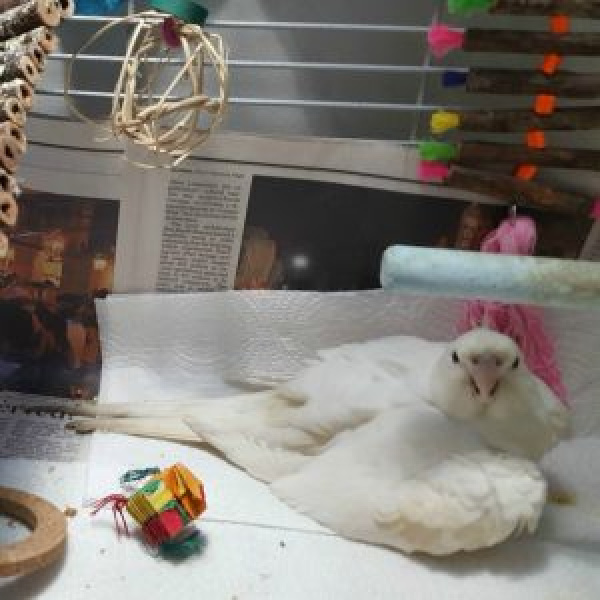

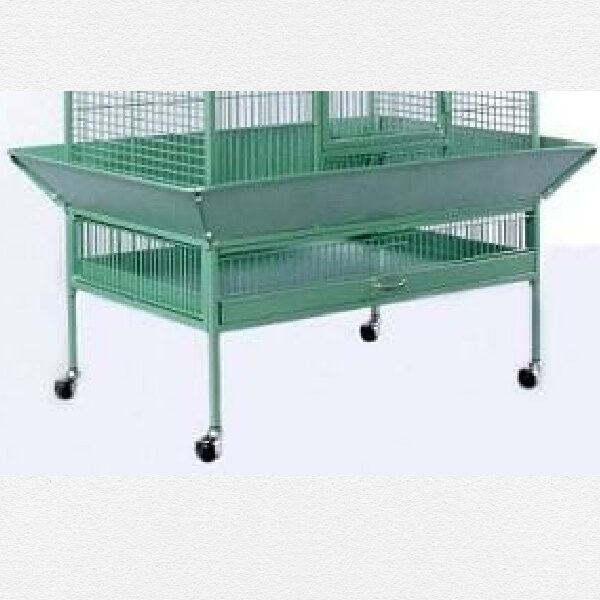


Alex Cats
17 Sep 2018Hello! Today my vet told me to have my bird under 72 hours of light. She is a chronic egg layer, and she actually has a large egg in her that we are hoping she will be able to push out D: she was given a calcium injection and instruction to eat some TUMS. Praying for my sweet gal, and hoping the 72 hours will curb her insane hormones!
WindyCityParrot
18 Sep 2018Kudos to your vet for not relying on chemicals Alex
The bird must stay in the cage with the cage cover OVER the light for full exposure.at night time.
The light should be no more than 6 inches over the cage.
After the 72 hours keep the light with a timer 12 on – 12 off which will help keep your birds circadian rhythm synched now that you’ve intentionally broken it
Should you see an egg after light therapy – repeat but for 168 hours.
This is not inhumane, you are keeping the bird alive.
The problems with Tums is inconsistent dosing..
A water soluble calcium supplement is superior.
Don’t try to mxs it daily, make a quart or half gallon for easy dispensing.
If you bird should go through a molt at this time, please ensure she’getting enough protein and supplements to help compensate for the dual caloric demand, growing feathers AND making eggs.
best of luck
mitchr
Alex Cats
18 Sep 2018Thank you so much for this info! I was instructed to do this with that egg in her belly, and I am just really hoping she is able to birth it.
WindyCityParrot
18 Sep 2018At least you know it’s there so if you don;t see it soon you can treat her as egg bound rather than losing the egg in the bird.
Check with your vet on that.
The moment you see the egg, toss it, you don’t want to encourage her wanting to be a mom.
Fresh water all the time but remove the food at night.
Abundant food encourages brooding behavior as well (she thinks “plenty to feed babies”)